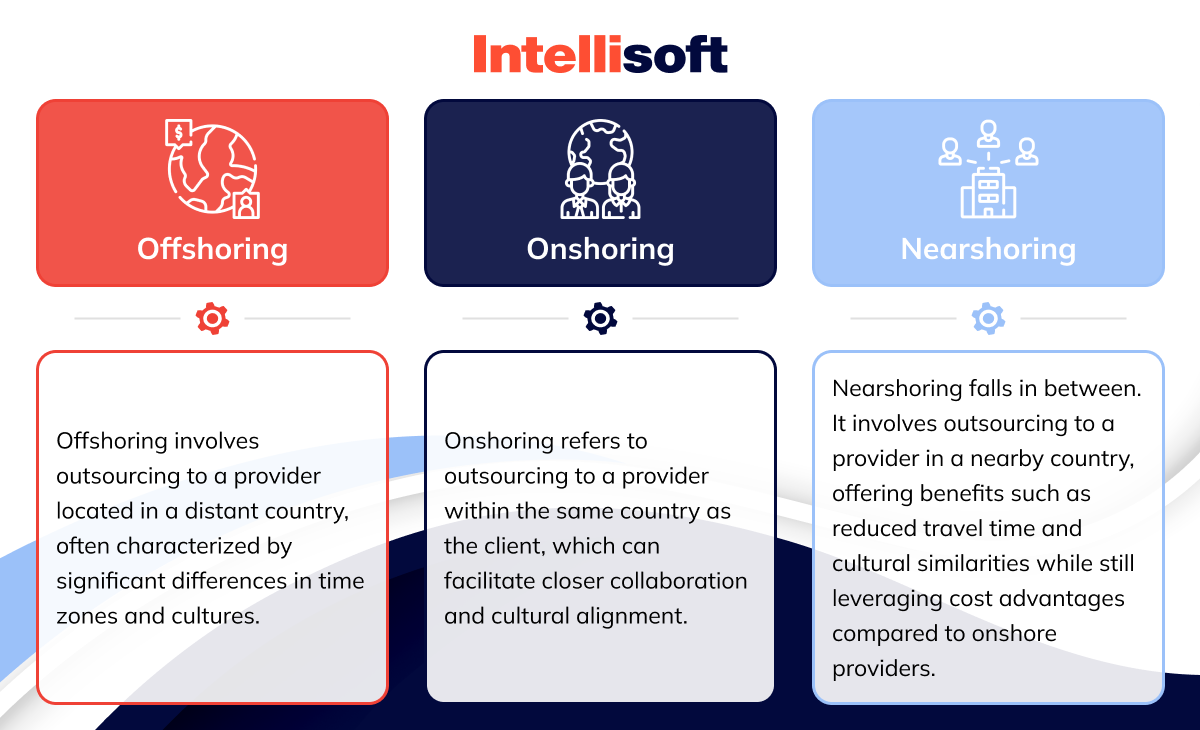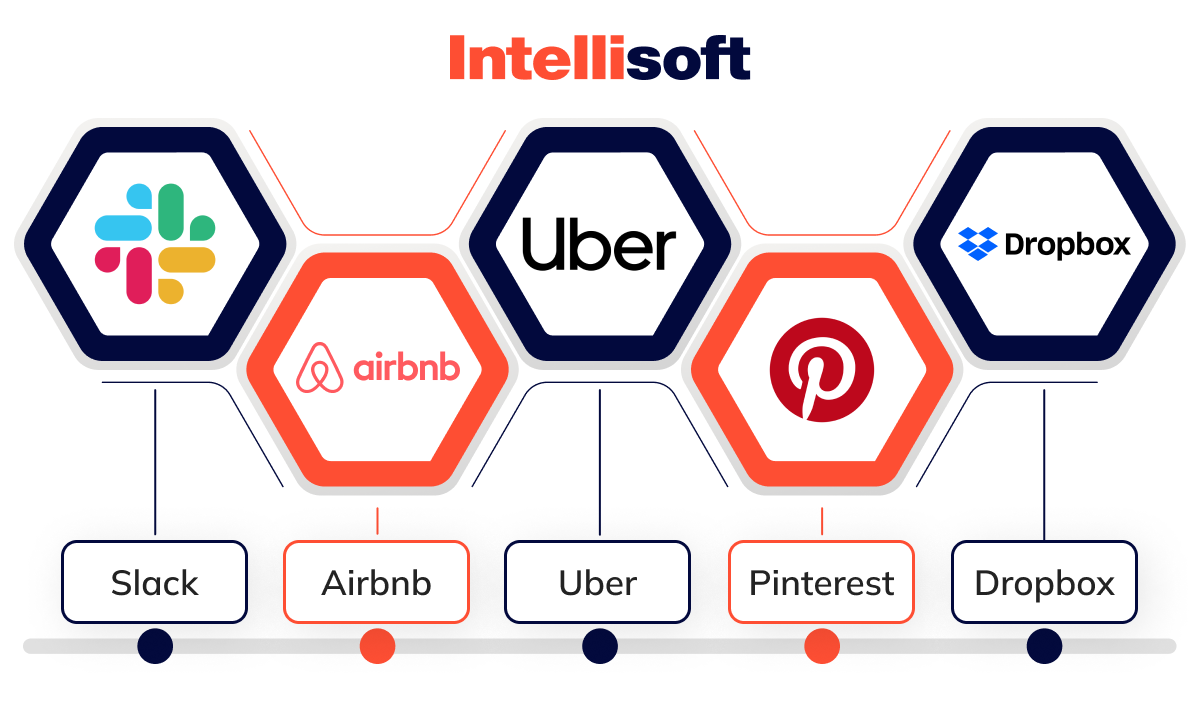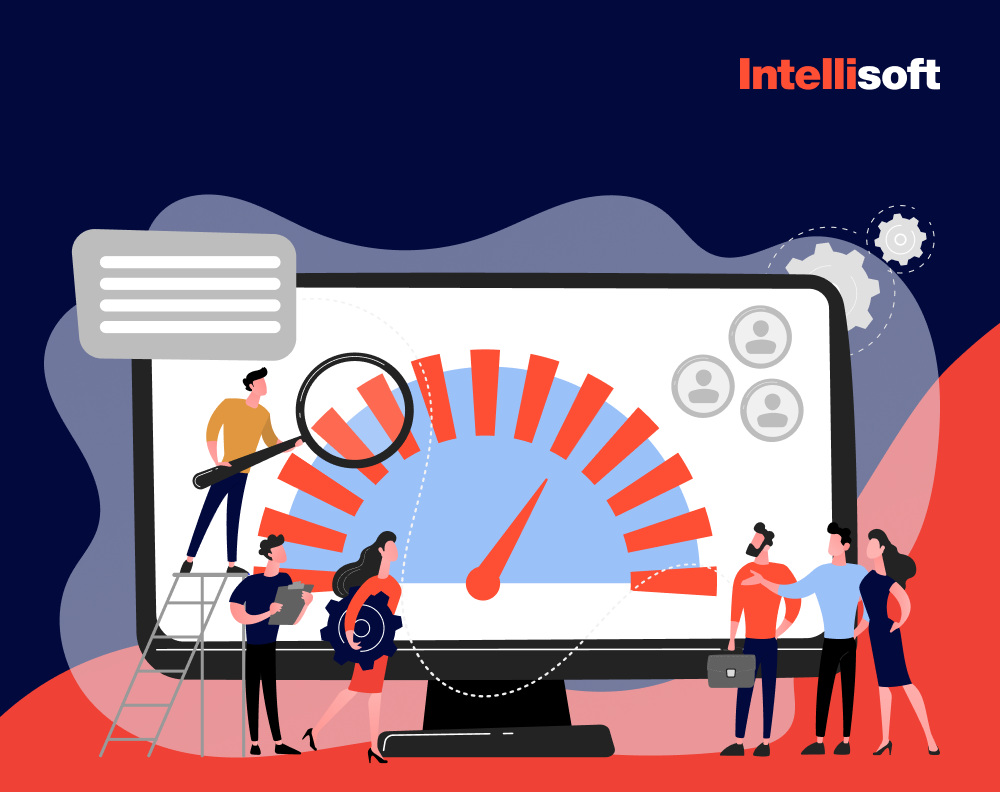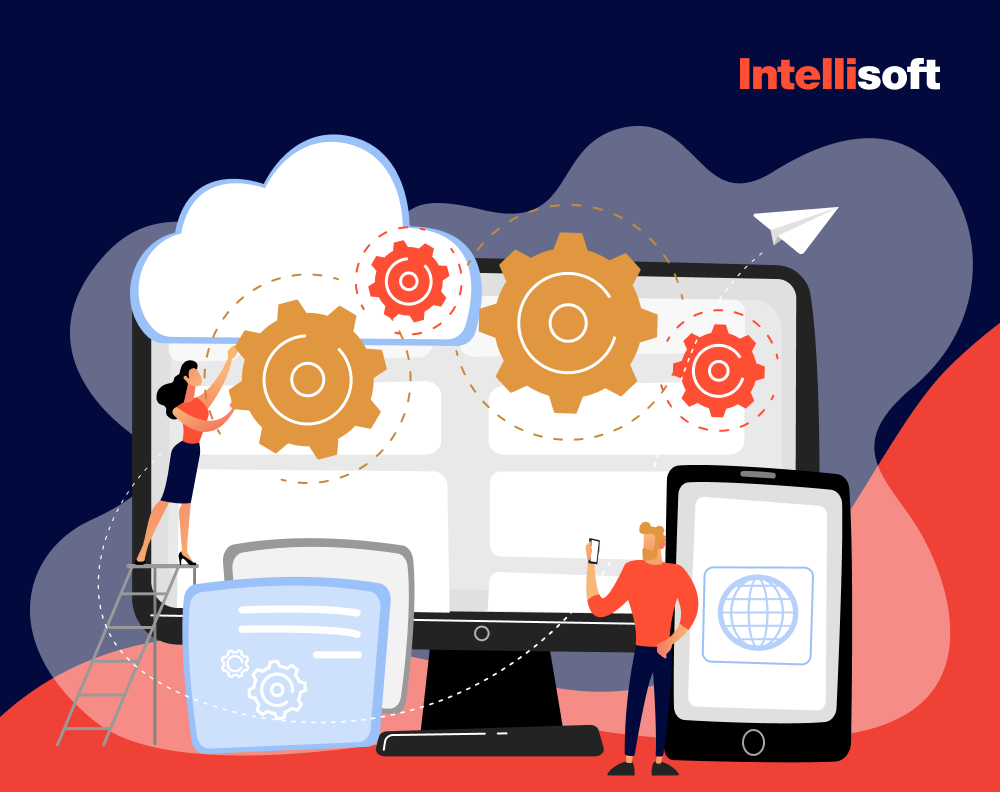Many businesses reach a point when they realize that managing the project on their own becomes impossible, either due to a growing demand or a skill gap. That is when they occur at the crossroads of choosing between IT project outsourcing and outstaffing. If you don’t have experience in delegating tasks to third-party providers, these two notions might sound similar, yet they offer different benefits and fit varying business needs.
Which one should you choose and why? You’re looking at the right place for an answer. IntelliSoft has been offering staff augmentation and outsourcing services for more than 13 years, and we know everything and even more about these cooperation models.
In this article, we’ll delve into the key differences between staff augmentation vs outsourcing, explore their respective advantages and disadvantages, and provide insights to help you determine which approach aligns best with your business objectives. Whether you need to scale your team quickly or seek specialized skills for a specific project, understanding these models will empower you to make the best decision for your company’s success.
Table of Contents
Staff Augmentation vs Outsourcing in Numbers
According to the National Association of Software and Services Companies (NASSCOM), the global outsourcing market was valued at $92.5 billion in 2020 and is projected to grow in the coming years, highlighting its significant role in the global economy.
ManpowerGroup’s 2020 Talent Shortage Survey reported that 42% of employers worldwide struggled to fill positions due to a lack of available talent. This situation often leads companies to seek staff augmentation or outsourcing solutions to meet their skill and expertise needs, particularly in high-demand sectors.
The International Association of Outsourcing Professionals (IAOP) found that the primary reasons companies choose to outsource are cost savings (65%), access to specialized skills and expertise (54%), and the ability to focus on core business functions (50%). These factors are crucial for businesses when deciding between staff augmentation and outsourcing.
Link:
What is an Outsourcing Model?
Outsourcing is delegating specific business processes or services to a third party with more expertise and skills than the IT company concerned. This approach allows organizations to focus on their core competencies while leveraging the specialized capabilities of external partners. It often entails contracting with an external provider for software development, customer support, data entry, or infrastructure management.
Outsourcing can take different forms depending on the geographical location of the service provider relative to the client company:

How IT Outsourcing Works
IT outsourcing is hiring another company to handle certain tech tasks for you. Here’s the gist:
First off, you figure out which parts of your tech operations you want to hand over. Maybe it’s managing your company’s website, handling customer inquiries, or developing new software.
Once you know what you need, you start looking for the right company to help you out. You search for a company that’s qualified and skilled at the things you need, fits your budget, and has a good reputation in the market.
Once you find a match, you negotiate the terms. You talk about what services they’ll provide, how much it’ll cost, and how long it’ll take. Then, you both sign a contract agreeing to the terms.
Next comes the transition. You give the outsourcing company all the info they need to get started, like access to your systems and a rundown of how things work.
While they work on your projects, you monitor them. You check in regularly to ensure everything’s on track and make any necessary adjustments.
And it’s not just a one-time thing. You keep working together over time, improving and adjusting as needed to keep your tech operations running smoothly.
Pros and Cons of Outsourcing
Outsourcing is not a one-size-fits-all solution; while offering a ton of advantages, it also has some drawbacks that you should consider before looking for an outsourcing partner. All of these can be avoided with the right approach and by choosing a reliable tech partner. Let’s look at the benefits and disadvantages of outsourcing:
Pros
- The vendor is fully responsible for the code quality and delivery.
- You will have more time to focus on your core tasks and business goals.
- You can spend less time managing it as the vendor will be responsible for it.
- The vendor will handle the recruitment process, scheduling, payroll, and benefits.
Cons
- A third-party vendor has more control over the project than you, which could be a con for some businesses.
- You risk spending more money than on an outstaffed project.
- There could be direct communication issues due to different time zones or language barriers.
Related Readings:
- What Is Nearshore Outsourcing in Software Development?
- Everything You Need to Know About Team Extension and Dedicated Team Models
- Five Things To Look For In An Ideal IT Offshoring Destination
- Cost to Hire Talent: Staff Augmentation vs In-House Recruitment
- Vendor Selection Process: Essential Criteria for CTOs’ Strategic Choices
What is Staff Augmentation?
In this case, the client already has an in-house team and requires help with a specific aspect of the project, temporarily expanding the team to meet a deadline, etc. This approach enables businesses to supplement their existing teams with specialized talent without the long-term commitment of hiring full-time employees.
This is a good option if you need specific skills ASAP and don’t have time to look for new in-house employees. With staff augmentation, you can temporarily hire the talent you need to achieve your business goals.
There are two payment models within the outstaffing cooperation type: the cost model and the cost-plus model.
The cost model presupposes hiring a part-time or full-time employee at a fixed monthly or hourly rate, making it perfect for short-term projects.
The cost-plus model gives you more control over how your team members are paid. Essentially, you pay salaries to the employed experts, purchase their gear, and provide bonuses and extra hours of pay.
How Staff Augmentation Works
Once you find a potential vendor, they outline the details of your cooperation, conditions, and specifications and present this data to you. If the outstaffed team works remotely, some experts may move and join your team if needed. Here’s how staff augmentation works in detail:
You contact a software development company and describe your projects, what you are looking for, the technology you would want to use, and the tasks that need to be completed. Once you send the message to the vendor, the company should accept that they are capable of working on your project.
Next, the vendor starts looking for the right people to complete the tasks. Once the people are hired, you come up with an agreement and sign it. Now, it’s your responsibility to direct the hired staff to perform specific tasks. You will also be paying the vendor for every hired employee.
Pros and Cons of Staff Augmentation
Let’s take a look at the benefits and drawbacks of staff augmentation:
Pros
- It is more affordable than outsourcing since you are in control of how many experts you hire. You don’t have to pay taxes, facility costs, insurance, benefits, and so on.
- You have more control since you are responsible for managing the hired employees; they become a part of your team for some time.
- Outstaffing allows you to hire the needed experts quickly and start the project right away, not wasting a minute.
Cons
- More responsibility can be a drawback for some companies.
- Setting and maintaining effective communication channels between the two parties is essential, or it can lead to misunderstandings and problems.
Major Difference Between Staff Augmentation vs Project Outsourcing
To make it easier for you to choose between staff augmentation vs project outsourcing, let’s compare their main differences, mainly the overhead costs, duties, location, project management part, and onboarding.
General Overhead Costs
Staff Augmentation
This model of cooperation is usually more cost-effective. In this case, you are paying only for the experts you need, and the cost to maintain the team is short-lived. You don’t have to pay taxes, benefits, and salaries – you only pay for the experts; the rest is handled by the vendor.
IT Outsourcing
Outsourcing requires higher upfront costs than staff augmentation. Why is this the case? Well, the outsourcing company provides long-term help and cooperation, taking care of multiple functions and services. In other words, you employ an entire development team, not just a couple of experts. The outsourced team is here to make your idea a reality from start to finish, hence the higher costs.
Main Duties
Staff Augmentation
In this case, you hire specific employees for required tasks. They work as part of your in-house team, complete the tasks, and then you stop working with them. The augmented staff’s scope of activities is narrower and more specific than that of outsourcing. Outstaffed experts have specific skills and expertise needed to complete your project and only serve you until that task is completed.
IT Outsourcing
Outsourcing covers a broader range of duties as the hired team usually takes care of the entire development process from start to finish. It operates separately, doesn’t have to do anything with the core business tasks, and is completely self-sufficient. Thus, you can focus on your core tasks while the outsourced company takes care of the rest.
Working Location
Staff Augmentation
Since you hire experts for specific gaps in your team, you can choose where they work from, either remotely or from your office. Thus, these experts can become a part of your in-house team for some time and work among them.
IT Outsourcing
With outsourcing, the team is usually located remotely: onshore, offshore, or nearshore. Since they work remotely from their own office, you don’t have to pay for the tech infrastructure, office space, and so on. Moreover, you are not limited to a specific location and can access the global talent pool, extending your possibilities and benefiting from high-quality services at a much lower cost.
Project Management
Staff Augmentation
Managing the outstaffed employees is your responsibility, mainly your project team lead. The project lead should manage the outstaffed experts just like the rest of the team. Since the augmented staff work directly under your supervision, you can quickly reallocate resources or shift focus based on project demands.
IT Outsourcing
A dedicated team is managed by the vendor, not you. The vendor has a team lead, a specific team structure and established management practices, and it’s their responsibility to manage the team. The processes and milestones are usually well-defined and agreed upon in the initial contract. This can result in less flexibility but offers more predictable outcomes and timelines. Your company’s role is to monitor the provider’s performance and ensure that the project stays aligned with your strategic objectives.
Onboarding
Staff Augmentation
In this case, onboarding is incredibly fast because the experts are hired short-term and can be onboarded seamlessly. The focus is on quickly integrating the new staff into your existing team structure and familiarizing them with your workflows, tools, and culture.
IT Outsourcing
The outsourced team should undergo a longer and more complex onboarding since they will be working on your project in its entirety. Outsourcing requires more investment in the selection of a vendor, contract negotiation, and the onboarding itself.
Outsourcing vs Staff Augmentation Practices
Various businesses use staff augmentation vs outsourcing differently depending on their needs, capabilities, and projects. To get inspired and choose between the two approaches more easily, here are examples of famous companies that used both approaches:

IBM
This company used both staff augmentation and outsourcing. Staff augmentation involves bringing in temporary employees with specific skills and expertise for a specific project, while outsourcing involves completing certain tasks or projects completely.
Google
Google used staff augmentation to bring in temporary employees to help its in-house teams. The company decided to work with outsourced experts in areas where the Google team lacked expertise.
Apple
Apple incorporates outsourcing as a key element of its business strategy, particularly for the manufacturing and assembly of its products. By outsourcing these tasks to external providers, Apple is able to save time and resources while leveraging specialized skills and expertise available in regions with established manufacturing capabilities.
Amazon
Amazon employs both staff augmentation and outsourcing as part of its business strategy. For specific skills or expertise required on a temporary or project basis, Amazon utilizes staff augmentation, bringing in skilled personnel as needed. Simultaneously, Amazon outsources certain tasks or projects to external providers to optimize operations and focus on its core competencies.
Staff Augmentation vs Outsourcing: Famous Startups
Numerous famous startups have relied on IT project outsourcing and staff augmentation on their path to success. They either used these practices to extend their in-house teams, fill in skill gaps, or delegate entire projects to outsourced teams. Their experience proves that outsourcing and staff augmentation are two popular approaches used by small startups and industry leaders.

Slack
Slack initially outsourced its design to a Canadian firm, MetaLab, during its early stages. This strategic move allowed Slack to benefit from top-notch design expertise without having to build an in-house team from scratch. The result was a sleek, user-friendly interface that contributed significantly to its rapid adoption and success.
Airbnb
Airbnb turned to outsourcing to develop its mobile application. By partnering with external experts, Airbnb quickly created a high-quality app that enhanced user experience and supported its expanding platform. This allowed Airbnb to focus on scaling its core business operations while ensuring its mobile technology kept pace with user demand.
Uber
Uber used staff augmentation to scale its engineering team quickly. By bringing in highly skilled contractors, Uber was able to rapidly expand its technical capabilities and meet the demands of its fast-growing platform. This approach allowed Uber to add expertise as needed without the long-term commitment of hiring full-time employees.
Pinterest
Pinterest outsourced various aspects of its software development to accelerate its growth. By collaborating with external teams, Pinterest could efficiently build and iterate on its platform features, allowing the company to focus on user growth and engagement. This strategy helped Pinterest scale its platform more effectively and stay ahead of competitors.
Dropbox
Dropbox leveraged staff augmentation to support its rapid growth and innovation. By augmenting its in-house team with specialized external talent, Dropbox could expedite development cycles and introduce new features faster. This approach enabled Dropbox to maintain its competitive edge in the cloud storage market.
Which is Better For Your Business: Project Outsourcing vs Staff Augmentation?
The choice between staff augmentation vs project outsourcing depends solely on your business needs and requirements. Both types of cooperation are beneficial and help businesses receive high-quality services for lower costs.
When is it better to outsource than outstaff, then? Everything depends on what you currently need.
If you already have a qualified and skilled in-house team and require help with a specific aspect of your business, go for outstaffing. This way, you will save money, be able to monitor the performance of the outstaffed team, and give more responsibility to the hired experts. The dedicated employees will fill in the gaps in your team and allow you to achieve your goals faster and more efficiently.
If you don’t have an in-house team and need to hire experts to work on your project from A to Z, outsourcing is your go-to solution. It is more than a cooperation model – it’s a long-term partnership, guaranteeing that all the aspects of your product will be taken care of, including post-launch support and maintenance.
Project Outsourcing vs Staff Augmentation Software Projects: How to Find a Right Contractor
Let’s say you have already chosen a cooperation model. It’s time for the biggest challenge now – finding the right contractor. With outstaffing, it won’t be much of a problem but get ready to spend some time looking for an outsourced team.
When you’re looking for a tech vendor, keep in mind that the right one should not only have the highest skills but a combination of the following:
- Abilities
- Experience
- Industry knowledge
Let’s move on to the stages of finding the right vendor.
Pre-Search Stage: Clarify your Needs, Goals, and Objectives
Start by defining the project scope and requirements. Clearly outline your goals, objectives, key deliverables, timelines, and any specific technologies or skills needed. For staff augmentation, specify the roles, skills, and experience levels required. For outsourcing, detail the entire project requirements and expected outcomes.
Next, assess your internal capabilities. Evaluate your existing team’s strengths and weaknesses to identify any skills gaps. Determine whether you need temporary augmentation or a complete outsourcing solution. Consider your team’s capacity to manage additional staff or an external project team.
Set a clear budget and timeline. Establish a realistic budget for the project, including a buffer for unforeseen expenses. Define a timeline for project completion, including milestones and deadlines.
Decide on your management preferences. Consider how much control you want to retain over the project. Staff augmentation offers more direct control and flexibility, while outsourcing transfers more responsibility to the contractor.
Search Stage: Research and Evaluate Contractors
Conduct thorough market research. Use industry reports, online reviews, and professional networks to identify potential contractors with a proven track record in similar projects.
Check the credentials and experience of potential contractors. Evaluate their experience, expertise, and past performance. Look for case studies, portfolios, and client testimonials. Verify their technical skills, project management capabilities, and familiarity with your industry or project type.
Request proposals and quotes from shortlisted contractors. Issue a Request for Proposal (RFP) with detailed information about your project requirements. Compare quotes and proposals to understand each contractor’s approach, pricing, and value proposition.
Assess communication and cultural fit. Evaluate how promptly and clearly potential contractors communicate during the evaluation process. Consider cultural fit, especially for long-term projects, and ensure their working style, values, and work ethic align with your organization’s culture.
Conduct interviews and assess technical skills. Interview potential contractors to gauge their expertise, problem-solving abilities, and approach to project management. For staff augmentation, conduct technical assessments or coding tests to ensure candidates meet your skill requirements. For outsourcing, evaluate the technical team assigned to your project.
Check references and reviews. Ask for and contact references to get firsthand feedback about the contractor’s performance, reliability, and ability to meet deadlines and budgets. Look for online reviews on platforms like Clutch, Upwork, or LinkedIn to gather more insights about their reputation.
Negotiate terms and conditions once you’ve identified a preferred contractor. Ensure clarity on project deliverables, timelines, payment schedules, and any contingencies.
For staff augmentation, agree on the duration of engagement, hourly rates, and any additional benefits. For outsourcing, establish clear Service Level Agreements (SLAs) and performance metrics.
By carefully navigating these stages, you can find the right contractor that aligns with your project needs and organizational goals, whether you choose staff augmentation or outsourcing for your software projects.
Wrapping Up
One one of the main tickets to success for an company is the right talent,a nd finding this talent is a quest. Whether it means creating an in-house team, outstaffing a part of business processes, or working with an outsourcing vendor – the choice depends on your unique business needs, and it involves thorough research.
How do you choose between outsourcing and outstaffing? Everything depends on what you expect to receive from the cooperation model and what part of your business processes will be delegated to employed experts. Consider your budget, needs, and expectations, and choose the option that suits you the most.
No matter what you choose, IntelliSoft can help with both. We have an outstaffing, a dedicated team model, and outsourcing services for clients all over the world. Contact us, and let’s choose the best model for you and find the best talent to deliver top-notch products and the highest-quality service.










